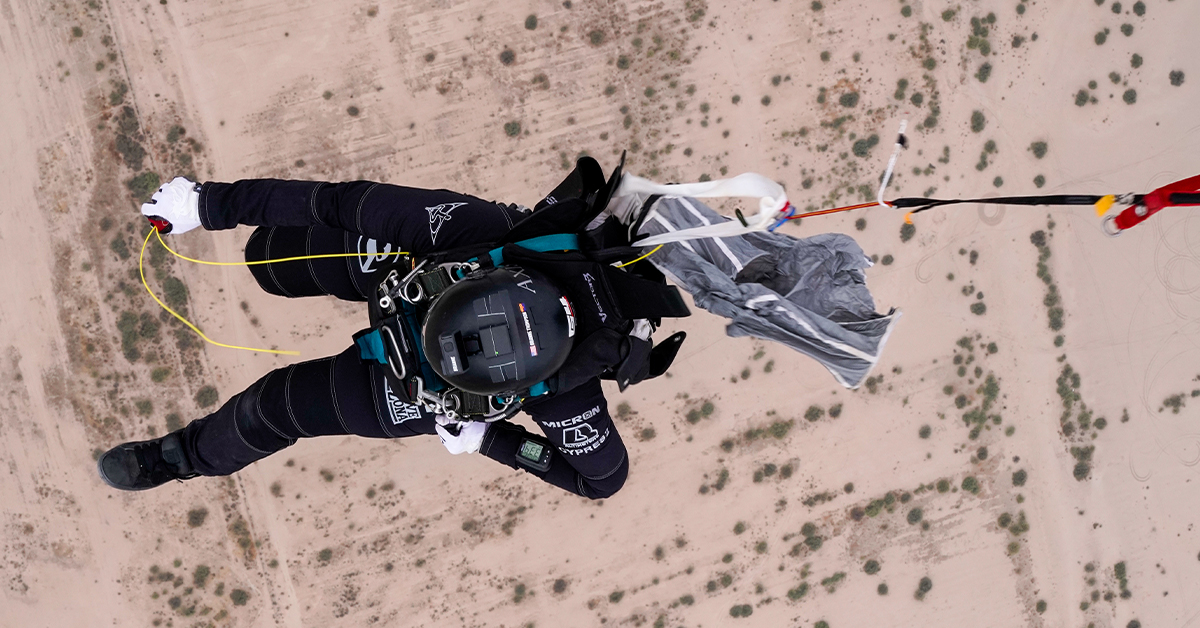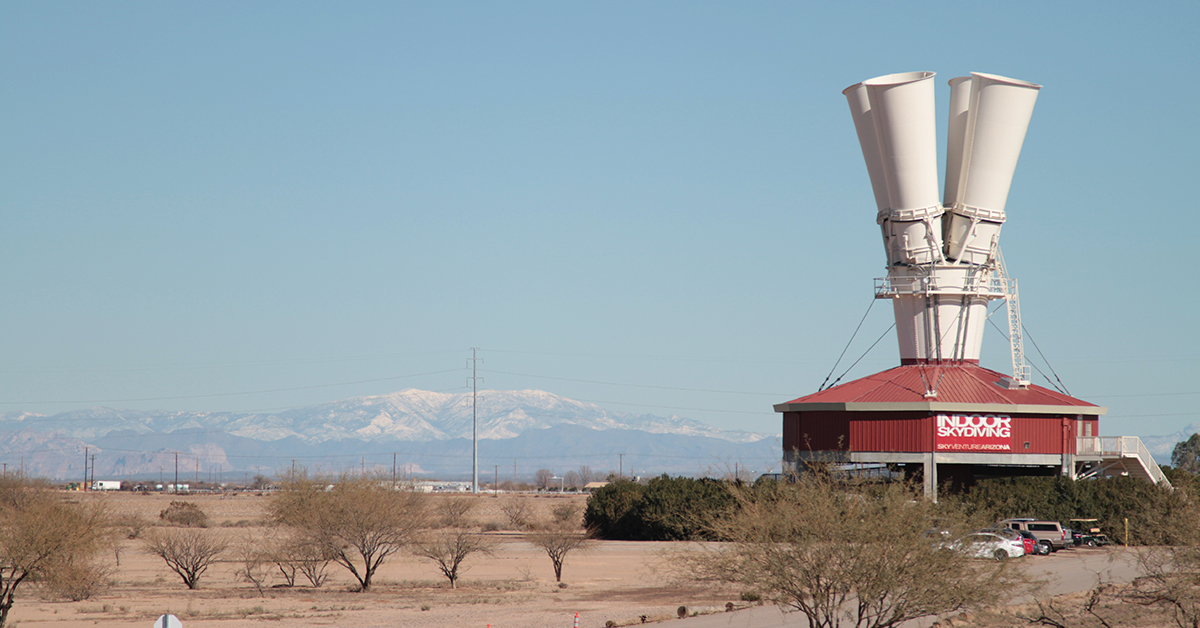Tricks and tips for jumping in the desert
Words by AXIS Flight School instructors Niklas Daniel and Brianne Thompson
Images by Niklas Daniel
Skydiving in the desert isn’t like skydiving anywhere else. The air feels different, the landings are faster, and the environment itself demands that you pay attention. But if you prepare properly, it’s one of the most rewarding places you’ll ever fly – especially for those jumpers used to waiting out rain showers and stubborn cloud in the UK.
Managing your body in the desert
The number one rule of desert jumping: hydration. In low humidity you can dehydrate without realising it. By the time you feel thirsty, you’re behind.
- Drink water constantly – sip all day rather than gulp occasionally.
- Balance electrolytes if you’re sweating heavily.
- Watch your teammates – irritability or fatigue can be early signs of dehydration.
Other body-care essentials:
- Cover your skin. Lightweight, breathable long sleeves keep you cooler than bare arms. Add a hat, sunglasses, and strong sunscreen.
- Take breaks. Step into the air-con or shade, eat a proper lunch, and pace your day.
- Moisturise. Chapstick, hand lotion, and eye drops go a long way in a dry climate.
With all that said: don’t be fooled. The desert can be cold, too! After a lifetime of grey British winters, you might be expecting the desert to scorch you with relentless heat, but temperatures drop quickly after sunset. Throw a hoodie or a beanie in your suitcase to pop on after the last load. You’ll be glad you did.
Gear care in sun and dust
Desert air is tough on kit. Protect your gear, and it will protect you.
- The sunshine can be very tempting, but pack indoors whenever possible. Pack in the hangar. It really is worth the walk.
- Keep your container clean. Dust on buckles and hardware can cause webbing to slip, so wipe it off with every pack job.
- Maintain your cutaway cables. Clean and lubricate them more often than you would at a moody-skied British dropzone.
- Don’t bake your rig. Leaving it in direct sun between loads invites UV and heat to shorten fabric life.

Flight characteristics in thin air
Density altitude changes how your parachute and your body perform. Here’s what to expect from high-desert field elevation.
- Deployments will be snappier compared to sea-level dropzones back home. Make sure your gear is in order and that you’re ready for brisker openings.
- Landings will be noticeably faster. Plan a longer, flatter flare, and give yourself more recovery room.
- Freefall speeds may feel subtly different. Be precise in your break-offs and separations.
- Canopy control requires more anticipation. Turns dive further than you might expect.
Luckily, the desert’s wide-open landscape gives you room to learn. Large designated landing areas are complemented by endless back-up options in the surrounding desert. Take advantage.
Weather awareness
If you’re used to checking the forecast in Britain and packing your waterproofs, the desert will feel like another planet. Rain-outs are almost unheard of in the (pretty much year-round) season… but the desert has its own quirks.
Dust devils, as you may already be aware, are the desert dropzone’s signature hazard. In the cooler, winter months, they’re less common – but never ignore the possibility.
First of all, if you meet one, don’t try to “outrun” it – like climbing a tree to escape a bear, that strategy is just not going to work. Because dust devils move with the wind – and we like to land against the wind – inexperienced jumpers often think they’re in the clear when they’re on their downwind leg. After all, they’re “outrunning” (in the sense of ground speed) the dust devil. It tends to be a nasty surprise when they inevitably go head-to-head with it on final.
If the winds are calm, a dust devil will usually remain stationary. When in doubt, take the best
course of action: stay (and land) upwind of a dust devil.
Further tips:
- Stay upwind of any visible dust columns, sure – but watch for invisible ones, too. They can be hard to see if they move over concrete and grass with no debris to pick up – or after an (unusual) rain. To see a “ghost dust devil,” look for wind indicators that are in close proximity to each other but pointing in opposite directions.
- Don’t let scanning for dust devils distract you from more familiar hazards. Mechanical turbulence from hangars, trees, or buildings poses just as much danger.
On the upside: clear skies are the norm in the desert, and ATC reroutes are rare. You’ll enjoy more full-altitude jumps in a single week than you might manage in an entire British winter.

Wildlife and ground hazards
Any given desert is bursting with life, and quite a lot of it is spikier and wilder than your bog-standard sheep. The landing areas around a desert DZ, often kept grassy for customers, can attract snakes, scorpions, or other small animals looking for shade and water. Treat these areas with respect. If you land out, scan carefully for critters before you gather your canopy.
Cacti and prickly bushes are also part of the landscape. They’re less dangerous than snakes, but your jumpsuit (and your canopy) may not thank you for ignoring them.
Making the most of desert skydiving
If you arrive prepared and savvy to its requirements, jumping in the desert offers a matchless environment for learning. The crisp winter air, reliable sunshine and long flying days mean you can progress faster here than almost anywhere else.
At larger desert dropzones – for instance, Skydive Arizona, where AXIS is based – that environment has allowed the skydiving infrastructure to evolve into a full-package experience. Here, for example, we enjoy the world’s largest skydiving fleet, which includes six Twin Otters and seven Skyvans. Jumpers at SDAZ can seamlessly combine coached jumps with time at the on-campus wind tunnel, using one to sharpen the other. Just a few days of this cycle can be worth months of weekend warrior jumping elsewhere.
The main season here in Arizona runs from October through to April, with peak activity from December to March – the very months when most UK skydivers are staring upwards morosely. And even besides jumping, Arizona has plenty to explore: hiking trails, desert landscapes and day trips to natural wonders like the Grand Canyon.
A final word
Travel and skydiving go hand in hand. Visiting a new dropzone exposes you to fresh weather patterns, different operating styles and new communities – all of which will help make you a stronger skydiver.
For UK jumpers, the desert offers something precious: the chance to
fly every day, all day, without waiting for the clouds to clear – and to build skills you’ll carry home with you.



